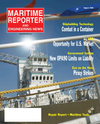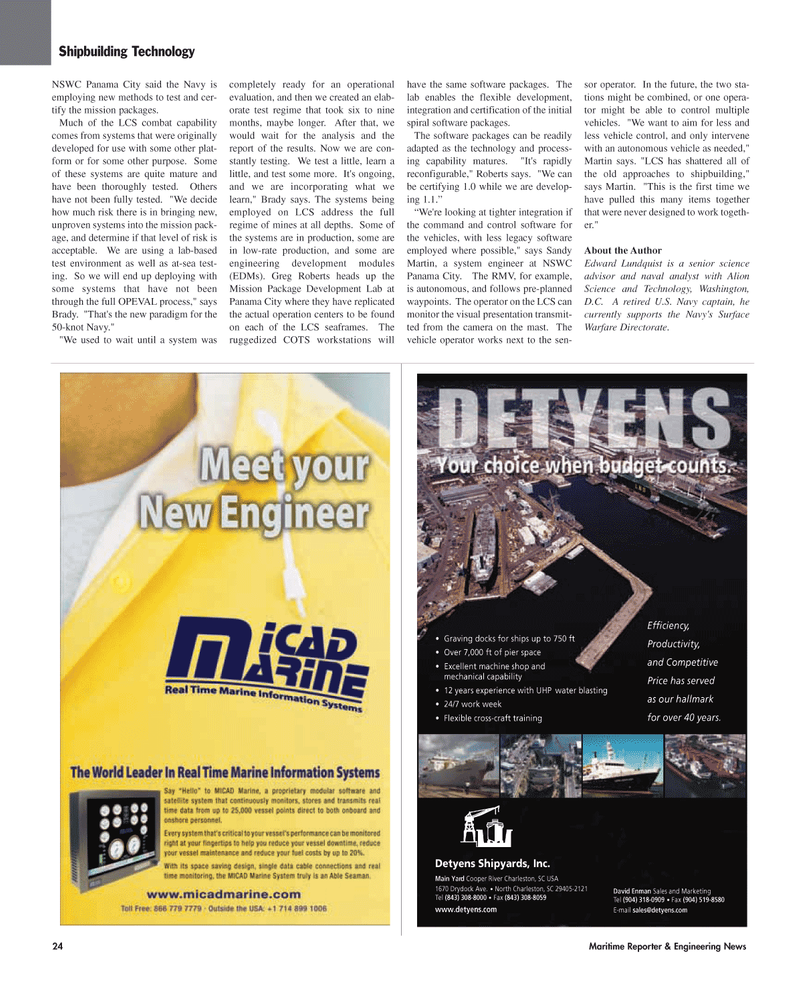
Page 24: of Maritime Reporter Magazine (August 2006)
AWO Edition: Inland & Offshore Waterways
Read this page in Pdf, Flash or Html5 edition of August 2006 Maritime Reporter Magazine
24 Maritime Reporter & Engineering News
NSWC Panama City said the Navy is employing new methods to test and cer- tify the mission packages.
Much of the LCS combat capability comes from systems that were originally developed for use with some other plat- form or for some other purpose. Some of these systems are quite mature and have been thoroughly tested. Others have not been fully tested. "We decide how much risk there is in bringing new, unproven systems into the mission pack- age, and determine if that level of risk is acceptable. We are using a lab-based test environment as well as at-sea test- ing. So we will end up deploying with some systems that have not been through the full OPEVAL process," says
Brady. "That's the new paradigm for the 50-knot Navy." "We used to wait until a system was completely ready for an operational evaluation, and then we created an elab- orate test regime that took six to nine months, maybe longer. After that, we would wait for the analysis and the report of the results. Now we are con- stantly testing. We test a little, learn a little, and test some more. It's ongoing, and we are incorporating what we learn," Brady says. The systems being employed on LCS address the full regime of mines at all depths. Some of the systems are in production, some are in low-rate production, and some are engineering development modules (EDMs). Greg Roberts heads up the
Mission Package Development Lab at
Panama City where they have replicated the actual operation centers to be found on each of the LCS seaframes. The ruggedized COTS workstations will have the same software packages. The lab enables the flexible development, integration and certification of the initial spiral software packages.
The software packages can be readily adapted as the technology and process- ing capability matures. "It's rapidly reconfigurable," Roberts says. "We can be certifying 1.0 while we are develop- ing 1.1.” “We're looking at tighter integration if the command and control software for the vehicles, with less legacy software employed where possible," says Sandy
Martin, a system engineer at NSWC
Panama City. The RMV, for example, is autonomous, and follows pre-planned waypoints. The operator on the LCS can monitor the visual presentation transmit- ted from the camera on the mast. The vehicle operator works next to the sen- sor operator. In the future, the two sta- tions might be combined, or one opera- tor might be able to control multiple vehicles. "We want to aim for less and less vehicle control, and only intervene with an autonomous vehicle as needed,"
Martin says. "LCS has shattered all of the old approaches to shipbuilding," says Martin. "This is the first time we have pulled this many items together that were never designed to work togeth- er."
About the Author
Edward Lundquist is a senior science advisor and naval analyst with Alion
Science and Technology, Washington,
D.C. A retired U.S. Navy captain, he currently supports the Navy's Surface
Warfare Directorate.
Efficiency,
Productivity, and Competitive
Price has served as our hallmark for over 40 years. • Graving docks for ships up to 750 ft • Over 7,000 ft of pier space • Excellent machine shop and mechanical capability • 12 years experience with UHP water blasting • 24/7 work week • Flexible cross-craft training
Detyens Shipyards, Inc.
Main Yard Cooper River Charleston, SC USA 1670 Drydock Ave. • North Charleston, SC 29405-2121
Tel (843) 308-8000 • Fax (843) 308-8059 www.detyens.com
David Enman Sales and Marketing
Tel (904) 318-0909 • Fax (904) 519-8580
E-mail [email protected]
Shipbuilding Technology
MR AUGUST2006 #3 (17-24).qxd 8/3/2006 7:23 PM Page 24

 23
23

 25
25
